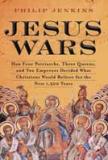The Origin of Orthodoxy
If you seek a credible study of how evil profoundly defiled ancient church councils, read Philip Jenkins’s new book, Jesus Wars. If you seek clarity about how one of those same church councils produced timeless teachings about Christ still honored by Catholic, Orthodox and most Protestant Christians today, you should also read this book.
This is a perceptive study that challenges the common wisdom about how lofty Christian doctrine was formulated amid human chaos, and it all centers on the Council of Chalcedon (451 C.E.)
The author helps the reader see that the key factors at work were often not religious but of other kinds. “When we look at what became of the church’s orthodoxy,” observes Jenkins, “so many of those core beliefs gained the status they did as a result of what appears to be historical accident or the workings of raw chance.”
It was not a matter of one side having better theological views than the other. All had good people and arguments. “What mattered,” the author points out, “were the interests and obsessions of rival emperors and queens, competitive ecclesiastical princes and their churches, and the empire’s military successes or failures against particular barbarian nations.”
In the long term, debates defining the meaning of Christ were settled by one straightforward issue: which side gained and held supremacy within the Christian Roman Empire and was therefore able to establish its particular view of orthodoxy.
In truth, the Roman Church became right because it survived. “It was all mere chance and accident—unless, of course, we follow a tradition common to Christians, Jews and Muslims of seeing God’s hand in the apparently shapeless course of worldly history.”
Jenkins is known for helpful insights like this. He teaches and writes at Penn State and Baylor Universities (previous books reviewed in America include The New Faces of Christianity and The Lost History of Christianity). Why study the protracted debates over the two natures of Christ, which was the theological thread running through that entire era? The author charts the course of theological evolution and shows that it was important to ancient audiences who believed theological orientation had practical consequences for state and society.
Why did ordinary people get so passionately involved in such intricate debates? Jenkins shows that when court rivalries shaped theological exchange, having the “right” theology meant having the kind of empire God favored. Even the slightest concession to error in such essential matters was understood to affect the substance of Christian truth.
Guided by Jenkins, readers can engage early councils strategically, without drowning in historical minutiae and are alerted to the developing story within the story. This era, remote to us, set precedents that influenced the Christian world ever since; the Catholic/Orthodox split; the Reformation; early-modern Victorian battles between faith and reason, and others.
Councils like Chalcedon are important because they debated pivotal, timeless issues like the quest for authority in religion, the relationship between church and state, the proper ways of interpreting Scripture, the ethics and conduct demanded of Christians, and the means of salvation.
What ultimately became known as Christian orthodoxy was hammered out in a process that was painfully slow, gradual and often bloody. We trace the development of Christianity and are helped to understand how it and other world religions evolve in new circumstances. For example, some modern African Christian and Islamic religious behaviors show parallels to ancient conciliar times.
Four sees played primary roles in the councils under consideration—Antioch, Alexandria, Constantinople and Rome. The councils were centers of political theater and action. Powerful prelates were linked to powerful political leaders. Fortunes rose and fell.
In defining Christ as both fully divine and fully human—having one personhood but two natures—Chalcedon formulated a solid theological base for communions like Rome and Constantinople. It also set the stage for the tragic condemnation of the Antiochene and Alexandrian churches. The Nestorian and Monophysite traditions were declared heretical. As a result, the emerging churches of Western Christendom effectively lost half their world.
Eastern Christendom was weakened through internal dissension and ultimately all but destroyed when Islam emerged as a new religious force with which it had to contend.
Many of the quarrelsome issues surrounding Chalcedon survive to modern times and remain alive in contemporary understandings, like the God who suffers with us—a view no longer viewed generally as heresy.
In his concluding chapter, Jenkins discusses what was saved from so much spiritual strife. After 1,500 years, the churches “have never found a path that avoids the powerful pressures of individual ambition and political interest. If nothing else, that experience argues strongly for being tolerant of nonessential expressions of the faith.”
Jenkins concludes with amazement that the church has preserved the core belief that Christ was human as well as divine. Today that belief remains standard teaching for the vast majority of Christians. We need constantly to re-examine and restate the grounds of our belief, since the Chalcedonian formula is not only our end, but also our beginning.
The author might well have entitled his book Back to the Future of Faith.
This article also appeared in print, under the headline “The Origin of Orthodoxy,” in the April 5, 2010, issue.








